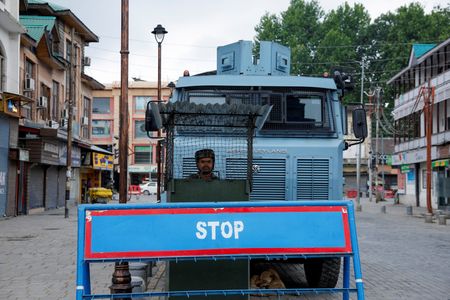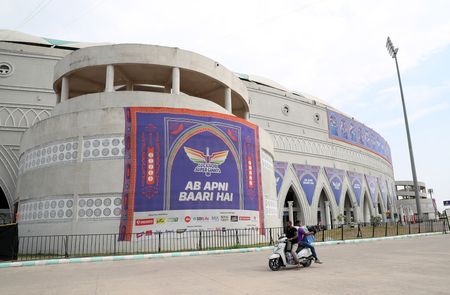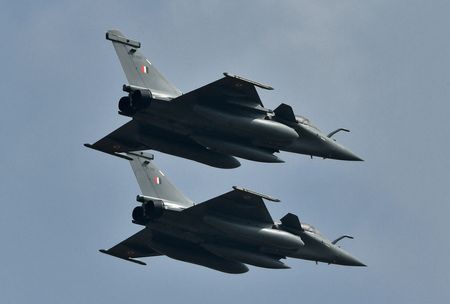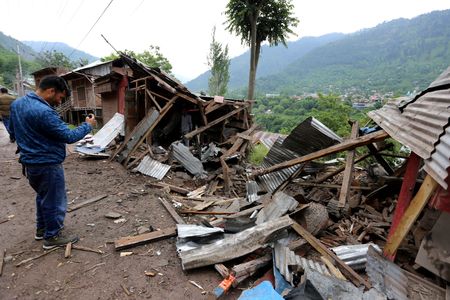May 9 – By Ira Dugal, Editor Financial News, with global Reuters staff.
The conflict between India and Pakistan heated up this week, stirring anxiety among diplomats, military brass and investors alike as they fixated on just how far the hostilities between the nuclear-armed neighbours may escalate.
This special edition of India File wraps up the developments in a fast-evolving conflict.
CONFLICT RATCHETS UP
India and Pakistan, nuclear-armed neighbours that share a 3,323 km (2,065 mile) border, have exchanged drone and missile strikes and engaged in air battles as their conflict escalated this week to the worst in nearly three decades.
Some Indian villages close to the border were evacuated, while on the Pakistan side the military said two of its largest cities, Karachi and Lahore, and the home to the army’s headquarters, Rawalpindi, had been targeted.
Drone attacks have been reported in Jammu city in Indian Kashmir, while television channels reported sightings of flares and projectiles in other Indian cities along the western and northwestern border.
On the diplomatic front, Pakistan’s U.S. ambassador said the two sides were in contact with each other, while U.S. Vice President JD Vance said the conflict was “none of our business”.
The conflict has drawn wide attention on a number of fronts: politicians and diplomats keen for de-escalation, military analysts seeking clues on how Chinese and European weapons perform against each other, and investors worried about the market and economic fallout.
On Wednesday this week India launched air strikes against targets in Pakistan that it said were “terrorist infrastructure”, in response to a deadly attack on tourists in Kashmir two weeks earlier.
Read this factbox to understand more about the targets India said it destroyed in those strikes and the groups it targeted.
Pakistan, which has denied involvement in the Kashmir attacks, said it shot down five Indian aircraft in response. The Indian embassy in Beijing has denied that.
To understand the history of the Himalayan region at the centre of the strife, read here.
ECONOMIC IMPACT
The conflict comes at a sensitive time for both economies.
India’s economic growth, hit by weaker domestic demand, slowed to a nearly four-year low of 6.5% in the financial year ended in March. The government of Prime Minister Narendra Modi is negotiating a trade deal with the U.S. to avert higher tariffs on its exports, and had just completed a long-discussed trade deal with Britain a day before the news of strikes inside Pakistan was disclosed.
By contrast, Pakistan’s economy, less than one-tenth the size of India’s, only recently emerged from an economic crisis as the government struggles to shore up its finances and make progress on a $7 billion International Monetary Fund loan programme agreed to last year.
Moody’s Ratings, in a statement before this week’s escalations, warned that “sustained escalation in tensions with India would likely weigh on Pakistan’s growth and hamper the government’s ongoing fiscal consolidation”.
Moody’s added that it does not expect major disruptions to India’s economic activity because it has minimal economic relations with Pakistan.
“However, higher defence spending would potentially weigh on India’s fiscal strength and slow its fiscal consolidation,” it said in its May 5 report.
The earliest economic and business casualties have been travel and tourism.
Airlines have had to reroute and cancel flights as airports near sensitive zones were closed and as both sides restricted the use of their airspace to each other.
Click on this graphics-based report to see how the India-Pakistan conflict pushed planes off course.
Tourism on both sides of the border, which had flourished especially on the Indian side of Kashmir where spectacular mountain scenery had lured middle-class vacationers, has come to a standstill.
Meanwhile, New Delhi is working to advance its hydropower capacity in the Himalayan region after it suspended a water sharing treaty with Islamabad, which sparked panic across Pakistan.
This factbox explains why that treaty could prove to be a powerful economic weapon.
A MUST-READ ANALYSIS
India and Pakistan have significantly upgraded their military capabilities since the nuclear-armed neighbours clashed in 2019, posing increased risks of escalation even in a limited conflict. Read this analysis by Saeed Shah and Shivam Patel of the two nations’ militaries.
Experts say India and Pakistan are considered closely matched in their capabilities with aircraft, missiles and drones, although India’s far greater resources would come into play over a longer period.
MARKET MATTERS
Indian markets – across currencies, equities and bonds – fell sharply on Thursday and were volatile on Friday after news of drone and missile attacks.
In the medium term, investors said they would keep the faith in India, which remains the fastest-growing major economy in the world.
Still, India’s nascent appeal as a safe haven amid global trade turmoil could be challenged, BreakingViews authors Una Galani and Shritama Bose wrote.
($1 = 84.4190 Indian rupees)
(By Ira Dugal; Editing by Edmund Klamann)








